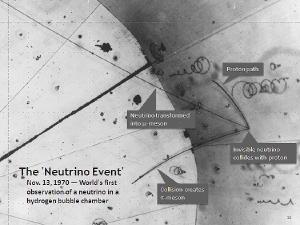Blog
Factor of Three
2 February 2014
In the mid-1800s, no one really knew how the stars shone. By this time we had a solid understanding of energy, and that energy is conserved. That is, energy must come from somewhere, and it must go to somewhere. We also had a general understanding of thermodynamics, specifically that you could squeeze something to heat it up. This gave us a mechanism which could cause the stars to shine, known as the Kelvin-Helmholtz mechanism. The basic idea of this mechanism is that for a large body like a planet or star, gravity tries to compress the star or planet smaller and smaller. This compression heats the core of the body, which is radiated as light. In this way a star could be heated by its own weight.
But for a star such as the Sun there is a problem. Gravity can only squeeze a body so far, so there’s a limit to how much heat can be generated by the Kelvin-Helmholtz mechanism. And by conservation of energy, once the Sun has radiated all its heat energy as light, it is done shining. It’s fairly easy to estimate the rate at which the Sun loses energy given its brightness and size. Its also fairly straightforward to calculate just how much energy the Sun could gain by gravitational compression. If you apply conservation of energy, then you can determine how long the sun could shine before it runs out of energy, and you get a clear answer: about twenty million years.
That’s quite a long time, but it disagreed horribly with geology, where fossil evidence demonstrated that life existed on Earth for several hundred million years, likely much longer. Then in 1905 Albert Einstein published his paper on special relativity. One aspect of special relativity is that energy and mass are two sides of the same coin. Mass can become energy and energy can become mass. Just how much energy you can get is surprisingly large. If we could convert one paper clip entirely to energy, it would cover the average person’s energy consumption for more than a decade. We soon came to understand that the Sun produces its light and heat by converting mass to energy through nuclear fusion.
 Argonne National Laboratory
Argonne National LaboratoryBut this raised another mystery having to do with the number of neutrinos emitted by the Sun. Neutrinos were first proposed by Wolfgang Pauli in 1930, but their existence wasn’t solidly confirmed until 1956. Neutrinos interact very weakly with other particles, so it took a nuclear reactor to produce enough neutrinos to be detected in the lab. Modern neutrino observatories, sensitive enough to observe solar and astrophysical neutrinos, are large arrays of detectors. Since neutrinos are byproduct of nuclear fusion, the Sun must produce neutrinos in its core due to the fusion of hydrogen. These solar neutrinos were detected in the mid 1960s, but it was found that the number of neutrinos was a third the expected amount. This result was repeatedly confirmed, and it became known as the solar neutrino problem.
The solar neutrino problem meant either our understanding of the temperature and pressure within the Sun was significantly off, or our understanding of particle physics was wrong. Since our understanding of particle physics was based upon laboratory experiments, it was thought that our Solar model must be wrong. There were several attempts to reformulate solar fusion models to account for the smaller neutrino rate, going so far as to propose that fusion in the Sun’s core had shut down temporarily. But over time these alternatives became increasingly untenable. Observational data supported traditional solar fusion models, therefore our understanding of particle physics must be wrong.
The physics of fundamental particles (electrons, neutrinos, quarks, etc) is described by what is known as the Standard Model. This model unified our understanding of electromagnetism and the nuclear forces known as the strong and weak. It described all known elementary particles, and even predicted new particles that were eventually observed. By the 1970s it was established as the theory of fundamental particles.
In the 1960s, it was found the the electron had two sister particles known as the muon and tauon, (together known as leptons) and that each of these had a corresponding neutrino. This meant that there were three types (or flavors) of neutrinos. According to the standard model, these neutrinos should be massless. This would mean that each flavor of neutrino only interacted with its corresponding lepton. The reason for this is that massless particles travel at the speed of light. They therefore don’t experience time, and can’t change their state. So a muon (which has mass) can decay into an electron, but a muon neutrino cannot change into an electron neutrino.
In 1968 Bruno Pontecorvo proposed that neutrinos had a small mass. This proposal would change the standard model slightly, but leave the overall predictions largely unchanged. The mass of the neutrinos couldn’t be large, otherwise they would have already been observed. But even the tiniest amount of mass would mean neutrinos could not move at the speed of light, and could therefore change flavors. This flavor-changing effect is known as neutrino oscillation.
 R. Svoboda and K. Gordan - LSU
R. Svoboda and K. Gordan - LSUNeutrino oscillation would explain the solar neutrino problem. The neutrinos produced in the Sun’s core would all be electron neutrinos, but as they moved through the Sun to its surface they would oscillate between the various types. By the time they reached the Earth, the neutrinos would be an equal mix of each type, meaning that only a third would be electron neutrinos. Since only the electron neutrinos were measured, the neutrino number would be a third that predicted by the standard model.
It wasn’t until 1998 that neutrino oscillation was confirmed. But with that discovery the solar neutrino problem was resolved. What began as a central mystery of our Sun ended with a deep understanding of particle physics.